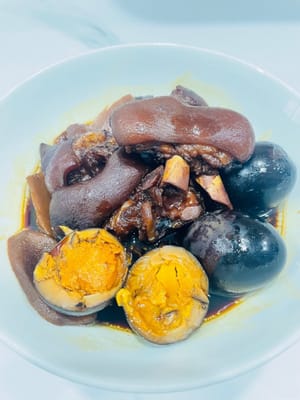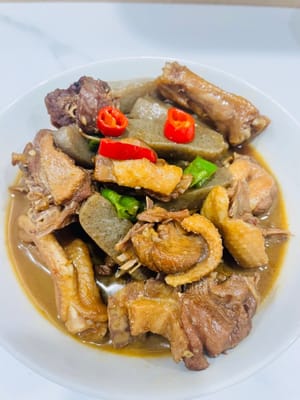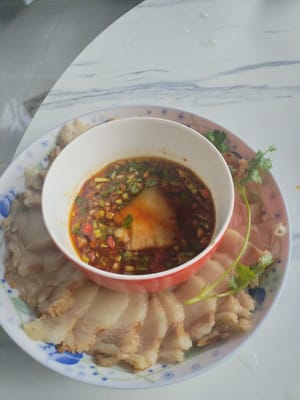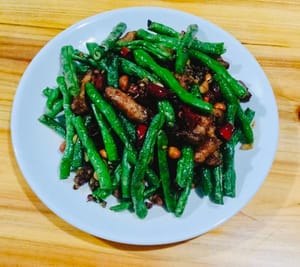What to Make with 10g Sichuan peppercorns – Fast, Fresh, and Tasty Ideas
Wondering what to do with 10g Sichuan peppercorns? Try these quick, healthy, and crowd-pleasing recipes.
Recipes with 10g Sichuan peppercorns

A small bowl of pork trotter with ginger warms the body and dispels wind, especially during autumn and winter—after all, putting on weight in autumn helps protect against the cold in winter! This delicious pork trotter with ginger is quite delicate to prepare. If preparing for someone confinement, start soaking the ginger two weeks in advance, bringing it to a boil daily and then turning it off. Soak for at least a week to fully unleash the ginger's aroma. My week-long pot of pork trotter with ginger is simply enticing: the trotter is a translucent brown, tender yet slightly chewy, and the flavor grows with every bite. The egg has a deep brown outer shell, but when cut open, the yolk is a firm orange-yellow, and even the core is imbued with the flavor of ginger vinegar. The ginger is crumb-free and not as spicy as those sold outside; it's refreshing and refreshing. The broth is just right—not sour, bitter, sweet, or thick—and even more flavorful than a carefully prepared broth. While Guangdong street vendors sell pig's trotters with plenty of ginger, a small piece of ginger, an egg, and a pig's trotter costs at least 20 yuan, and the flavor isn't quite there. It's nothing like home-cooked pork trotters, which are both affordable and flavorful, with every bite filled with heartfelt warmth. Speaking of which, in the month after my "divine beast" was born, we used a total of 150 pig's trotters! I just wanted to nourish my family, but the aroma filled the hallway. As if they had "smell radar," the neighbors would come to my house every day to "freeload" and take their meals away, treating me like a "makeshift pig's trotter delivery station." Everyone said my pig's trotters were so delicious they almost wanted to take the pot home with them!

Watercress and Kidney Soup is a classic Cantonese soup. The salty aroma of the kidney stimulates the appetite and aids digestion, while also adding a richer flavor to the base. The combination of sweet and apricot kernels moistens the lungs and relieves coughs, without leaving a dry taste. The watercress, with its inherent sweetness, softens and dissolves in the broth, clearing heat, moistening the lungs, and promoting urination. This soup is refreshing and soothing, relieving both greasiness and dryness. No wonder Cantonese people love it!

This Sichuan-Chongqing konjac beer duck is perfect for those on a weight-conscious diet! The konjac's chewy texture is smooth and chewy, absorbing the fresh aroma of both the duck and beer. While it doesn't have much of a flavor of its own, it perfectly locks in the meat's flavor. The duck is stewed to a crispy tenderness, and the beer not only removes the fishy smell but also adds a refreshing sweetness from the malt. The salty and savory flavors, combined with the spicy Sichuan peppercorns, make the dish even more delicious with every chew. The key is that the konjac is incredibly filling; just a few bites will fill your stomach. Paired with rice soaked in the sauce, it's a satisfying snack without the worry of gaining weight. For those of you who are trying to control your weight but crave this dish, you'll love its tangy aroma and satisfying feeling. Every bite is a win-win for both deliciousness and weight management!

Sichuan and Chongqing's salty shaobai (rice shao) is a melt-in-your-mouth pork belly. The fatty, glutinous pork belly is not greasy at all, while the lean pork belly is perfectly flavorful. The chopped bean sprouts are salty and fragrant, with a crisp and flavorful chew. Mixed with the pork belly, the combination of salty and sweet flavors is so fragrant it's almost intoxicating! In Sichuan and Chongqing, this dish is a common dish at banquets and restaurants. I, a meat-averse person, saw this shaobai (rice shao) at my grandmother's house and tried a piece. My eyes widened, and I devoured the entire plate! Since then, I've become a true meat-eater. Every time I go back to my grandmother's house, the first thing I shout is, "I want shaobai!"

The beef slices are light red, the preserved eggs are dark brown with white lines, and they are dotted with emerald green coriander and bright red chili peppers, creating a sharp contrast in color. The beef is chewy, the preserved eggs are smooth and slightly elastic, and the fresh fragrance of the seasoning wraps the ingredients, which is salty, fresh, slightly sour, and has a unique mellow feeling of preserved eggs. The more you chew, the more delicious it tastes.

:After being blanched and rinsed with cold water, the long beans retain their crisp and tender texture, and they make a crisp sound when chewed, giving people a refreshing feeling.

Boiled pork: Provides energy and nutrition: Pork is rich in protein, fat, vitamins (such as B vitamins) and minerals such as iron and zinc, which can supplement the energy and nutrition needed for daily life and maintain normal physiological functions of the body. - Fresh taste and easy to digest: Boiled pork is cooked by boiling, which retains the fresh taste of the meat to the greatest extent. Compared with other greasy cooking methods, it is easier to be digested and absorbed by the human body, suitable for people of different ages. - Meets dietary needs: As a classic dish, boiled pork can be eaten with soy sauce, minced garlic, sesame oil and other condiments. It tastes delicious and can satisfy people's taste buds. It is a common delicacy on the table.

Stir-fried pork belly with stir-fried green beans is a combination that is so delicious that you will stomp your feet! Stir-fry the pork belly until it is golden and oily, and the aroma of fat mixed with the aroma of meat comes out first, and then wraps with the roasted green beans after stir-frying. Each bean is full of gravy, crispy on the outside and tender on the inside with a greasy feel. When you bite it, you will first taste the salty, fragrant and tender taste of the pork belly, and the fat will melt in your mouth, followed by the roasted and slightly spicy aroma of the green beans. The sweetness of the beans is more obvious with the aroma of meat, and the salty, fresh and spicy interweaves on the tip of your tongue, making you want to scrape away the rice crust at the bottom of the pot. With rice, you can eat the whole bowl directly, and you have to lick the oily fragrance at the corners of your mouth after eating, which is very satisfying!